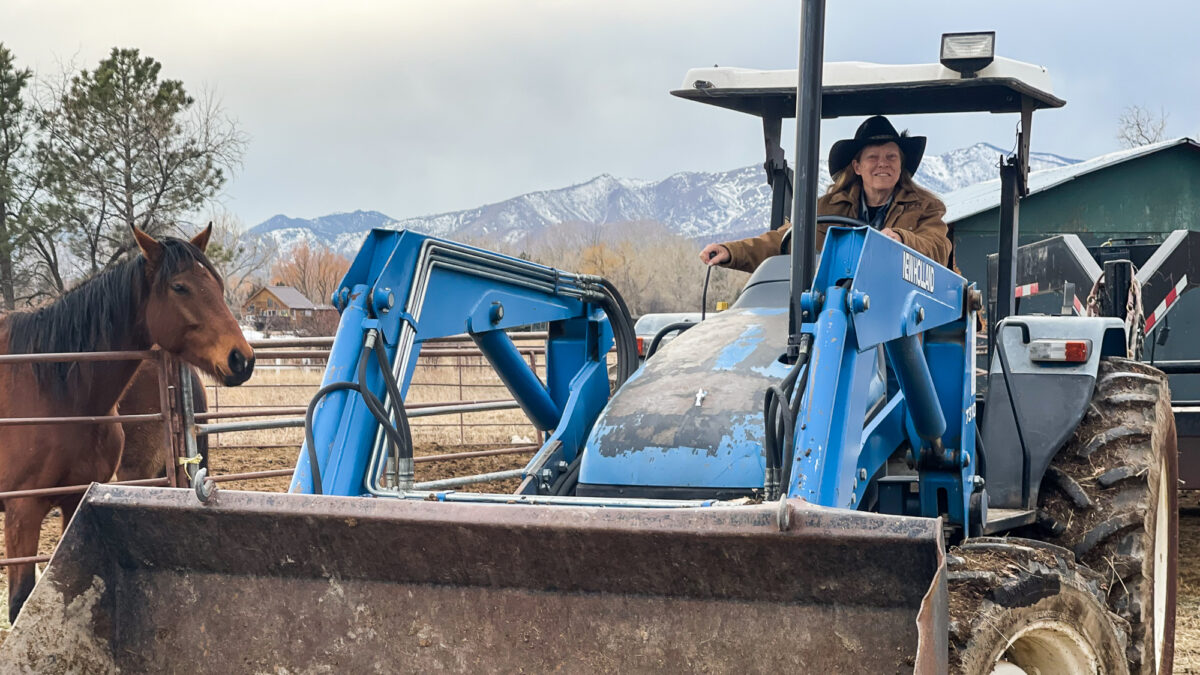Combine it with renewables, and you could reverse global warming
Highlights:
- Regenerative agriculture sequesters carbon, and fixes the farming business model
- It produces more nutritious food, helps protect our health, and generates profits
- Adopting regen ag globally would displace all the carbon we now emit
Meet Gabe Brown. If you haven’t read his groundbreaking book Dirt To Soil, visited his North Dakota farm, seen his Netflix documentary Kiss The Ground, or his Congressional testimony, you can find Gabe speaking around the country about regenerative farming.
Brown describes how regenerative agriculture not only fixes farming, but also the farming business model. It delivers more nutritious food, healthier rural culture, and enables smallholder farmers worldwide to feed themselves and the rest of us. It’s also essential if we want to solve the climate crisis.
“Regen ag,” as it’s called, enables farmers and ranchers to sequester enormous amounts of carbon in the soil — and at a profit. If farmers around the world adopt the practice, it will start to roll climate change backward. Couple that with renewable energy, and it solves the climate crisis.
Regenerative agriculture enables farmers and ranchers to sequester enormous amounts of carbon in the soil — and at a profit. If farmers around the world adopt the practice, it will start to roll climate change backward.
“It’s unbelievable, the change,” Gabe told Farmers Weekly. “Finally, there is the realization that while agriculture is part of the problem, it can be a bigger part of the solution… Regenerative practices can not only help farmers, but society as a whole, no matter where your interests lie.”
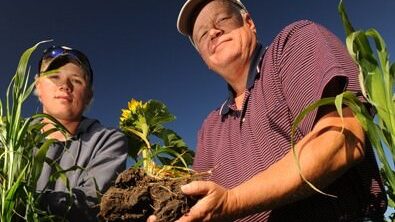
Gabe and Paul Brown. Credit: Brown’s Ranch
He’s right: Regenerative agriculture enhances native biodiversity — and cuts costs. Water use is optimized, because the carbon-rich soil better holds moisture. Improved farm worker safety and investment in local businesses better sustain stressed farming communities. Because more people may be needed to do work that chemicals previously did, regenerative farming creates jobs. Because region ag melds the best of modern science with ancient culture, farm life becomes more rewarding and sustainable. For insight on different approaches, see A Finer Future, Creating an Economy in Service to Life.
In contrast, industrial agriculture is energy-intensive, polluting, destructive of rural communities, and hazardous to our health. It both worsens and is threatened by climate change. In 1940 Americans produced 2.3 calories of food energy for every calorie of fossil fuel energy we used. Now it takes 10 calories of fossil-fuel energy to produce a single calorie of modern supermarket food. Think about that.
Gabe’s journey
Ironically, it was his early failure with industrial farming that drove Gabe into regenerative agriculture, and led to his now enduring success. Storms, droughts, and the deaths of crops and cattle at the 2,000-acre farm he took over from his in-laws in 1991, led him to step back from the industrial farming practices they had used. To survive, he became one of the pioneers of no-till planting, year-round diverse cover crops, “animal impact” and soil improvement.
Gabe’s operation is now very profitable. But “we’re not in this to make a profit this year. We’re in it to regenerate our soil — and long-term profitability,” Gabe told the Center for Regenerative Agriculture and Resilient Systems. “And because we’ve gone to this (regenerative) production model, we’re able to produce our cash commodities at a fraction of the cost.”
When Gabe took over the farm, which grew corn and soybeans, soil quality was poor after generations of commodity farming. The shallow topsoil required annual inputs of fertilizer, pesticides, and herbicides to grow anything. In 1995, Gabe switched to no-till production. This cut his costs. He then diversified into a variety of cash crops and began rotating his fields. In 1997, he started using deep-rooted multi-species cover crops.
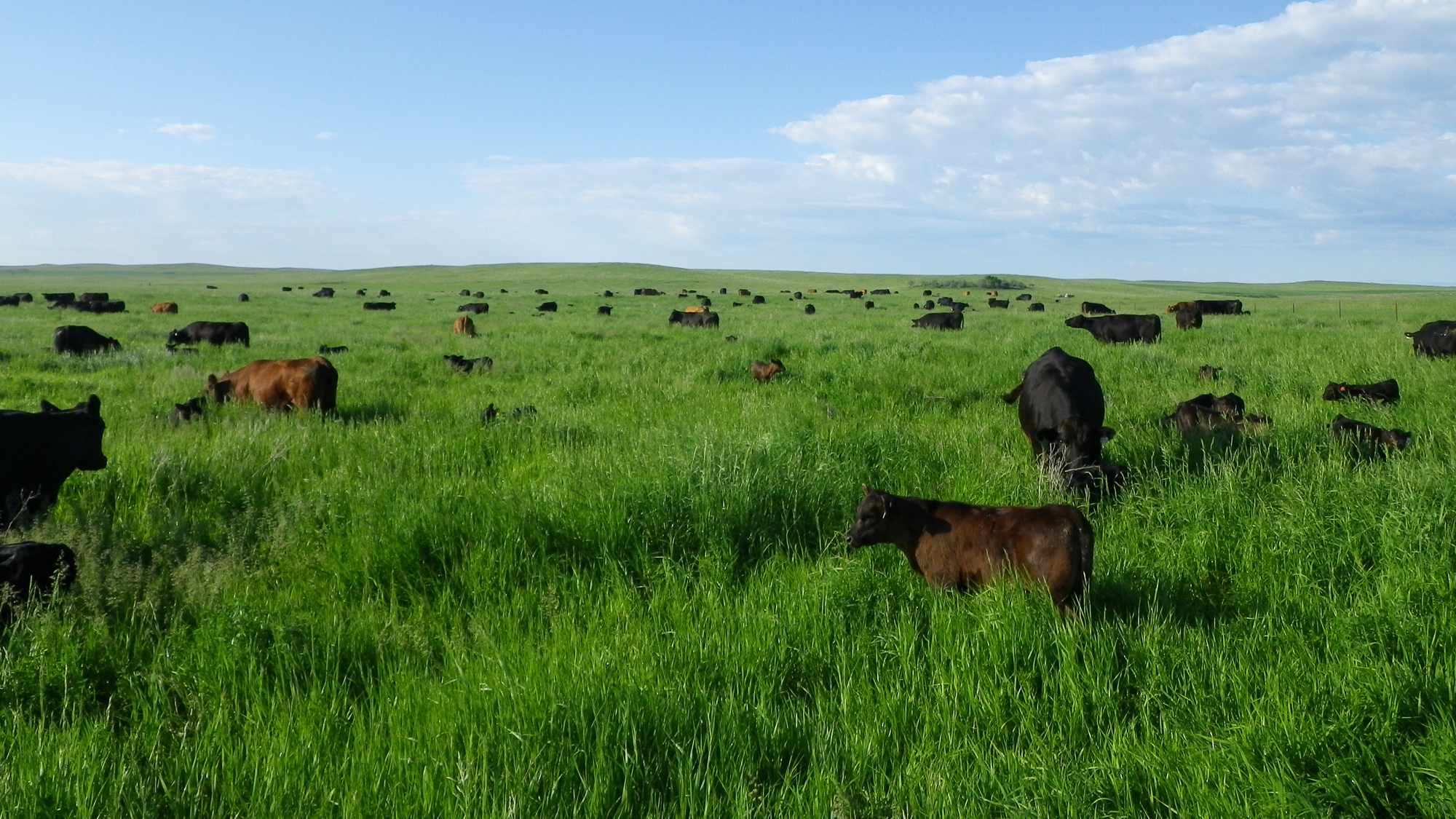
Credit: Brown’s Ranch
In 2006, Gabe introduced the Holistic Management techniques pioneered by Allan Savory. He added different livestock species, so that he now raises cows, sheep, broiler hens, and bees as well as corn and soybeans. His system has allowed him to cut chemical inputs, dramatically reducing his costs and increasing his profitability.
Related articles:
Is there a place for beef in a climate-friendly future?
12 women cultivating sustainable food systems in 2023
A global food crisis calls for soil resilience
By 2014, it cost him $1.35 to produce a bushel of corn, which he sold for more than $3.50. Now Gabe, his son Paul, and the rest of the family who run the farm while Gabe globe trots, cannot keep up with demand for their grass-finished beef and lamb. And their fields are healthy.
Regenerative practices sequester vast amounts of carbon
What Gabe is doing is more than just a better way to feed people. When coupled with elimination of carbon emissions by using renewable energy, regenerative agriculture is the other half of the solution to the climate crisis. Its practices enable farmers to sequester vast amounts of atmospheric CO2 as mineralized soil carbon, reversing the climate crisis while making a profit.
Renowned soil scientist Dr. Rattan Lal of Ohio State University calculates that improved soil management can sequester 178 billion tons of atmospheric carbon by 2100 and that when combined with increases in biomass, can drop atmospheric CO2 concentrations by 157 parts per million (ppm). If our current loading of CO2 into the atmosphere could be halted, the reduction via soil and biomass improvements could get us to 263 ppm. That’s a pre-industrial level sufficient to actually reverse the warming trend – not just slow it down.
Improving soil carbon with better agricultural practices also alleviates the threat of drought. According to the Natural Resources Defense Council (NRDC), every 1% increase in soil organic matter (SOM) increases the soil’s water holding capacity by 20,000 gallons per acre. Thus, a 50-acre farm that improves its soil organic matter by 2%, say from 1% to 3% (a realistic scenario), will hold an additional 2 million gallons of water after each rain. The numbers get big quickly.
Organic oil matter (SOM) also improves the “biodiversity of beneficial microorganisms that provide nutrients for plants, (increases) nitrogen (and controls) soil-borne plant diseases,” Regeneration International reported. “The decomposition of plant and animal residues into SOM can provide all the nutrients needed by plants and negate the need for synthetic chemical fertilizers, especially nitrogen fertilizers that are responsible for numerous environmental problems.”
When Gabe started farming in 1991, organic matter was as low as 1.3% in his soil (58% of which is carbon). By 2013, he had plots with more than 11 percent soil organic matter, some higher. As Gabe puts it, if your soil is healthy, you will have clean water, clean air, healthy plants, healthy animals, and healthy people. Grass-fed beef is higher in omega-3 fats than fish, but without the mercury, Yes, cows emit methane, but when they are on grass, the methanotrophic bacteria render it harmless. You will have a healthy ecosystem.
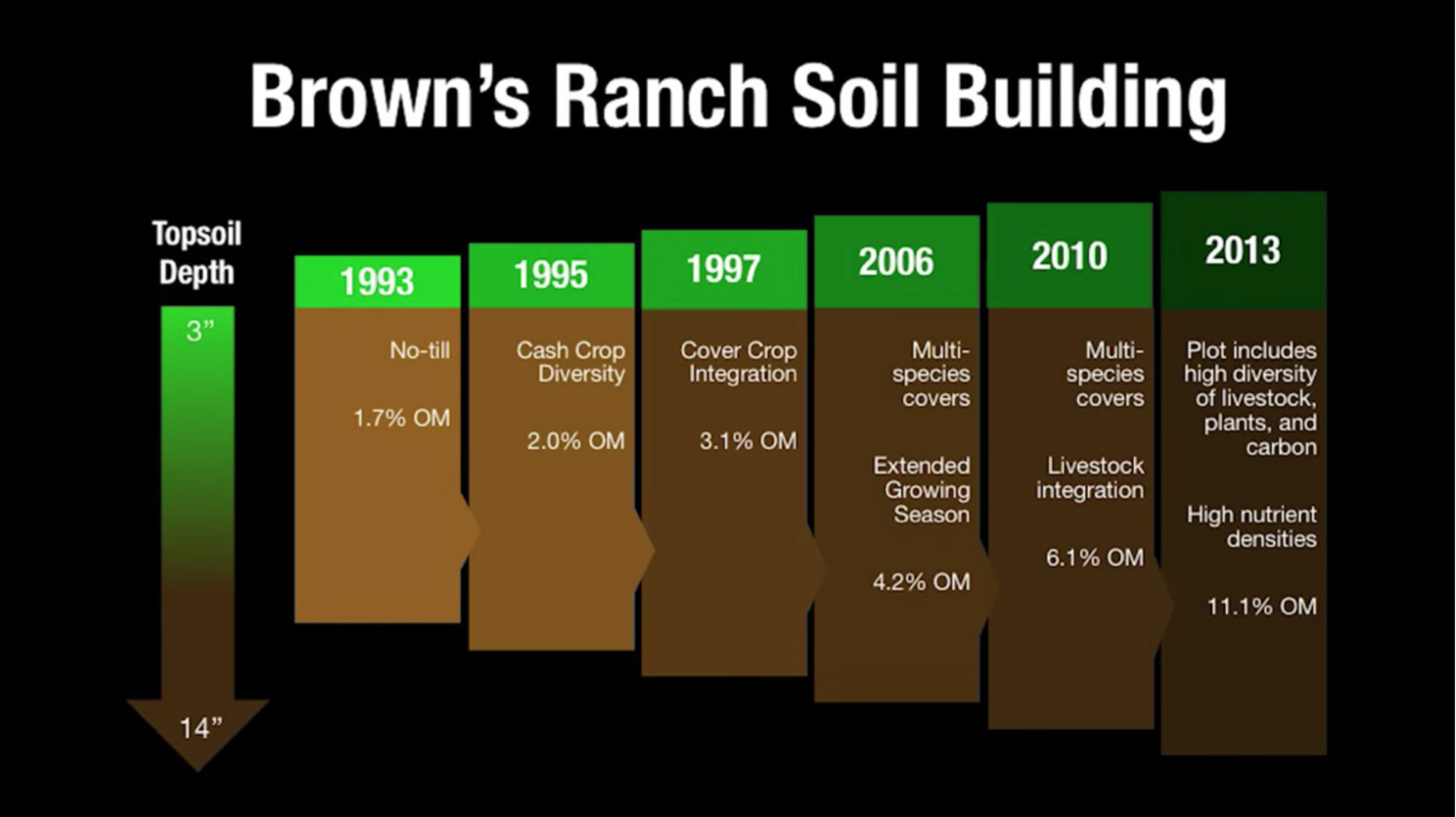
Source: Brown’s Ranch
Gabe’s increase of water-extractable organic carbon (WEOC) means that he is rolling climate change backward — recarbonizing his soils — and at a healthy profit. Regenerative grazing, pioneered by the Savory Institute, enables producers like Gabe to be climate heroes. Market mechanisms and soil health verification protocols, such as the Savory Institute’s Land to Market and Ecological Outcome Verification helps producers prosper with these replicable, verifiable practices.
“Finally, there is the realization that while agriculture is part of the problem, it can be a bigger part of the solution.”
Gabe is not alone. “Regen ag” is spreading rapidly. A holistic system of farms, farmers, and customers, regen ag balances the relationship between nature and the community to enhance all. It nourishes the soil on which life depends, especially the microbial life that sequesters carbon in the soil. Organic vegetable production, long advocated by Rodale Institute, restores soil structure, builds healthy topsoil, nurtures soil microbes, and promotes biological activity, all of which contribute to long-term productivity and nutritious crops.
In fact, Rodale Institute reported in a white paper, that the enormous amount of recent data on soil carbon sequestration shows that regenerative agriculture “could drawdown more than 100 percent of annual CO2 emissions.”
Zambian pig farms dramatically increase soil carbon
Seth Itzkan of Soil4Climate cites new work in Zambia where pig farmers, using mobile cages, are achieving dramatic increases in soil carbon. He writes:
Using this method, Sebastian Scott has increased his soil organic matter (SOM) from approximately 0.5% (typical for the sandy soil in the area) to 2.5%. For those of you doing math at home, that equates to 9.6 TONS of carbon per acre or 24 TONS of carbon per hectare increase. Over large enough areas (such as the size of Zambia) that equates to 1.8 billion tons or 1.8 gigatons of sequestered carbon.
The numbers get large, quick, and if you’re trying to mitigate global warming, this is what you want. Of course, this is more than just a carbon play, for each additional 1% of SOM (such as from 1% to 2%), you are increasing the water holding capacity by 20,000 gallons per acre or 50,000 gallons per hectare. Converting to liters, this is about 190,000 liters per hectare. Think that would mitigate drought and extend the growing season in semiarid areas?

Mpanshya Community Herd Project, Zambia. Mobile pig pen in a crop field. Credit: Seth J. Itzkan
These regenerative farmers use compost and manure from livestock as fertilizer, supplanting synthetic nutrients derived from natural gas. In recent California experiments, manure from dairy and beef operations was blended with green waste that would otherwise go to landfill, impose costs, rot, and release methane. The mix is composted and spread on pastures.
Scientists from the University of California, Berkeley, took annual soil cores a meter deep and tested whether that soil had soaked up additional carbon. One application of compost to rangeland doubled grass growth and increased carbon sequestration by up to 70%. Every year the carbon content has increased. The study found that this land treated with organic amendments achieved greenhouse gas (GHG) mitigation rates of more than 18 tons of CO2-equivalents per acre.
Sequestration of just one metric ton per hectare — 2.47 acres — per year on half the 23 million hectares of rangeland in California would offset 42 million metric tons of CO2, equivalent to all of the annual GHG emissions from energy use for commercial and residential sectors in California.
David Johnson, director of the Institute for Sustainable Agricultural Research at New Mexico State University, developed a similar approach. His research has shown that promoting beneficial interactions between plants and soil microbes increases farm and rangeland’s efficiency for capturing carbon and storing it in soil. These interactions increase soil microbial carbon-use efficiencies, reducing the rate at which soil carbon, as CO2, is respired from the soil. When this biotechnology is promoted in agroecosystems, it is feasible to capture and sequester an average of 11 metric tons of CO2 per hectare per year in rangeland soils and more than 36.7 metric tons CO2 per hectare per year in transitioning farmland soils, all for less than one-tenth the cost of mechanical Carbon Capture Utilization and Storage (CCUS) technologies.
Using his Biologically Enhanced Agricultural Management approach (BEAM), Johnson developed to create fungal-dominated compost, he documented that during an agricultural field study lasting 4.5 years, there was a 25-times increase in active soil fungal biomass and an annual average capture and storage of 10.27 metric tons soil carbon per hectare per year (approximately 38,000 pounds of CO2 per acre per year). That’s 20 to 50 times the observed soil carbon increase in the 40 equivalent no-till soils tested.
Crop yields were also dramatically improved. Johnson reports that the cotton he used in his testing grew 6 feet high and produced over five bales of cotton per acre without fertilizers, herbicides, or insecticides. The average in his area is about two and a half bales per acre. Australian farmers using similar methods have seen yields of 3 tons of wheat in the regions that produced about 1.6 tons previously.
How much carbon can be sequestered?
Carbon Underground and Soil4Climate believe that regenerative agriculture can displace all of the carbon emitted by humans each year and begin rapidly mitigating global warming. A wealth of documentation on Soil4Climate shows how soil can sequester carbon and reverse climate change.
A Tufts University research team wrote,
Soil carbon restoration is emerging as a potential strategy to mitigate global warming while also enhancing food and water security. The Paris Agreement, although a laudable achievement for the international community, is insufficient to meet its primary goal of 2 degrees Celsius by 2100, while scientists have warned that 1.5 degrees Celsius is the maximum that should be permitted to avoid catastrophic impacts. To close the emissions gap between nationally determined contributions under the Paris agreement and necessary carbon reductions to prevent the most extreme climate disruptions, extensive sequestration of carbon dioxide from the atmosphere is required.
Globally, soils have the potential to sequester up to 3.4 GtC (gigatons of carbon) per year, just enough to close the “emissions gap.” If combined with other atmospheric CO2 removal efforts, such as reforestation, yearly additional carbon capture in soils and forests could be as high as 5 GtC per year. When combined with deep cuts in fossil fuel emissions, this could lead to a substantial overall reduction in atmospheric carbon dioxide.
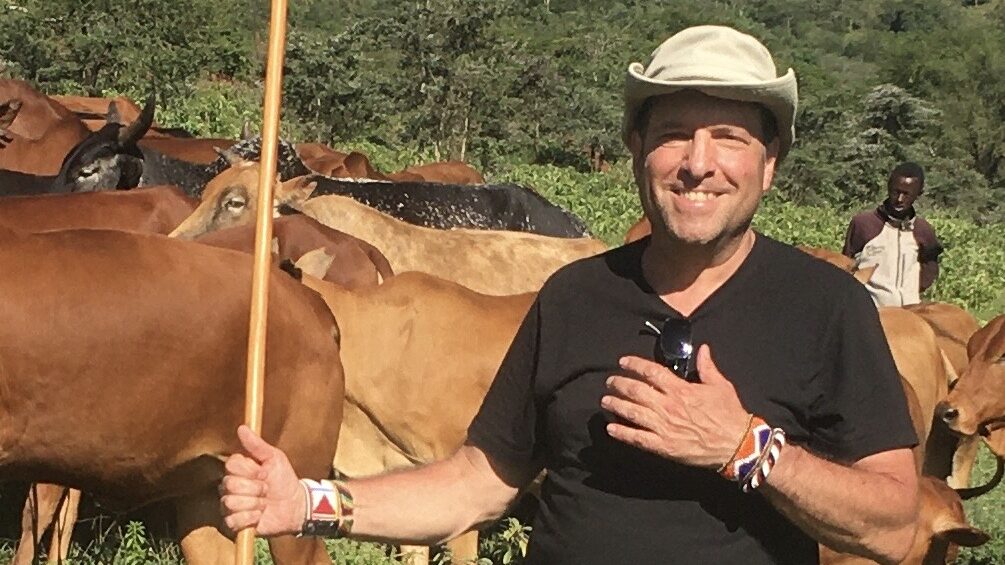
Seth Itzkan working with a holistically managed Maasai herd in Kenya. Itzkan is co-founder of Soil4Climate, founder of Planet-TECH, and a member of the UN Food Systems Summit (UNFSS) Coalition, Sierra Club Food and Agriculture Team, and the Savory Institute Advisory Board. Credit: Seth Itzkan
Texas A&M soil scientist Richard Teague, chronicles what he calls Adaptive Multipaddock (AMP) grazing (holistic management in all but name) in east Texas. He has measured the sequestration of “3 tonnes of carbon per hectare per year over a decade (tC/ha/yr).” Soil scientist Megan Machmuller measured the increase in carbon in a conversion from row cropping to management-intensive grazing, achieving as high as 8 tonnes per hectare per year in Georgia, or almost three times the amount measured by Teague.
The same features that allow a steady churn of cheap meat also provide the perfect breeding ground for airborne diseases like the coronavirus.
Scientist Greg Retallack provided a paper in 2013 that should end the debate on whether soils can be the answer to the climate crisis. He showed that
…global expansion of grasslands and their newly evolved, carbon-rich soils over the past 40 million years may have induced global cooling and ushered in Pleistocene glaciation. Grassland evolution has been considered a consequence of mountain uplift and tectonic reorganization of ocean currents, but it can also be viewed as a biological force for global change through the coevolution of grasses and grazers. Organisms in such coevolutionary trajectories adapt to each other rather than to their environment and so can be forces for global change. Past farming practices have aided greenhouse gas release. Modern grassland agroecosystems already under intensive human management can reverse this, serving as a carbon sink. Carbon farming techniques can reclaim desertified land and help curb anthropogenic global warming.
Scientists know that the earth decarbonized itself from 1,000 ppm of CO2 in the atmosphere to the 280 ppm that existed when humans first evolved. If Retallack is correct, we can do it again, using the exact mechanism of grazing animals, at the same time that we produce nutrient-dense proteins and regenerate rural economies.
Is it fast enough?
How rapidly can this happen? Current global emissions from fossil fuels are about 10 gigatons of carbon per year (GtC/yr). Teague and his colleagues calculated that almost a gigaton could be soaked up in North American soils. The world’s permanent pasture and fodder lands are roughly 3.4 billion hectares. Back-of-the-envelope calculations by Soil4Climate’s Itzkan show that multiplying Teague’s carbon capture findings of 3 tC/ha/yr (conservative when compared with the 8 tC/ha/yr values Machmuller identified) by the global hectares of pastureland gives 10.2 GtC/yr potential soil carbon capture via grazing.
That, alone, would offset all human emissions. Itzkan and his colleagues point out that this calculation assumes only modest sequestration. If more aggressive assumptions are used, and renewable energy displaces current emissions, it would be possible over 60 to 100 years-time to return atmospheric concentrations of carbon dioxide to 280 parts per million, the pre-industrial level.
Daniel Rirdan, in his book, Averting Global Collapse, described the numbers necessary to scale this approach. Using current global livestock numbers of 2.24 billion standard animal units, rangeland and crop/pasture land could carry 10.33 billion livestock. Doing this would require a minimum of 2.5 million herders (assuming 1,000 head per herder). Like most regen ag, Holistic management is labor-intensive, not a bad thing in a world needing jobs.

Holistically managed cows at the Mpanshya Community Herd Project in Zambia. Credit: Seth J. Itzkan
What all of this makes clear is that far from needing fewer grazing animals, we need a lot more, but managed very differently. As Russ Conser of Blue Nest Beef says, “It’s not the cow, it’s the how.” Animal impact is critical to achieving the carbon sequestration we so desperately need. Some advocates claim that the answer to the climate crisis is to stop eating meat. To ease the transition, they offer fake meat.
There are a number of reasons why this is a non-solution. For starters, fake meat is, well, fake. Worse, it won’t help. A study of the regenerative operations at Will Harris’ White Oak Pastures found that regen ag sequesters at least 3.5 (about 1.3 kilograms) of carbon being stored in White Oak Pastures’ soil for every pound of White Oak Pastures beef meat. In comparison, Impossible Burger admits that their industrial monocultures of GMO-soy or peas for their meat substitute release at least 3.5 lbs of carbon dioxide equivalent for every pound of fake meat that is consumed.
“The irony is you’d have to eat almost exactly one pound of our grass-fed beef to offset the carbon emitted from eating a pound of their stuff made from commodity crops,” laughed Harris.
Climate heroes solve poverty, too
But you don’t have to eat the cows. In 2015, Vijay Kumar, Executive Vice chair of Rythu Sadhikara Samstha (Farmers’ Empowerment Organization), began working with small-holder farmers in India, where cows are sacred. First in Andhra Pradesh, now with millions of farmers in nine Indian states, Vijay is helping villagers transition away from the use of chemicals to what he calls Community Managed Natural Farming. Traditionally, Indian farmers plant one crop a year, timing their efforts so that the seedlings emerge just as the monsoon rains arrive. Under a changing climate, the monsoons come too late, too heavily or not at all. The 1968 Green Revolution had promised an end to famine, India’s historic scourge, by using artificial fertilizers, pesticides, mechanization, and irrigation. The promised increases in yield proved fleeting, and these costly practices led to debt, health problems, farm failure, poverty, and recently, suicides.
To counter this, Vijay helps smallholders (farming one-acre plots) use Gabe’s principles of minimal disturbance of the soil, biomass covering the soil year around, living root always in the soil, diversity of plants and animal impact, plus four concepts indigenous to India: use of locally made biostimulants crafted from plant wastes and cow manure; pest management through botanical extracts; use of indigenous seed; and total rejection of synthetic fertilizer, pesticides or herbicides. Sequestering large amounts of carbon, this type of regen ag increases soil moisture so that farmers can harvest crops year around. It increases the diversity of farm diets, health of farmers, their families and farm communities. Vijay’s interventions have helped farmers triple farm productivity and increase profits from 43,000 rupees previously to 106,900 rupees using natural farming.
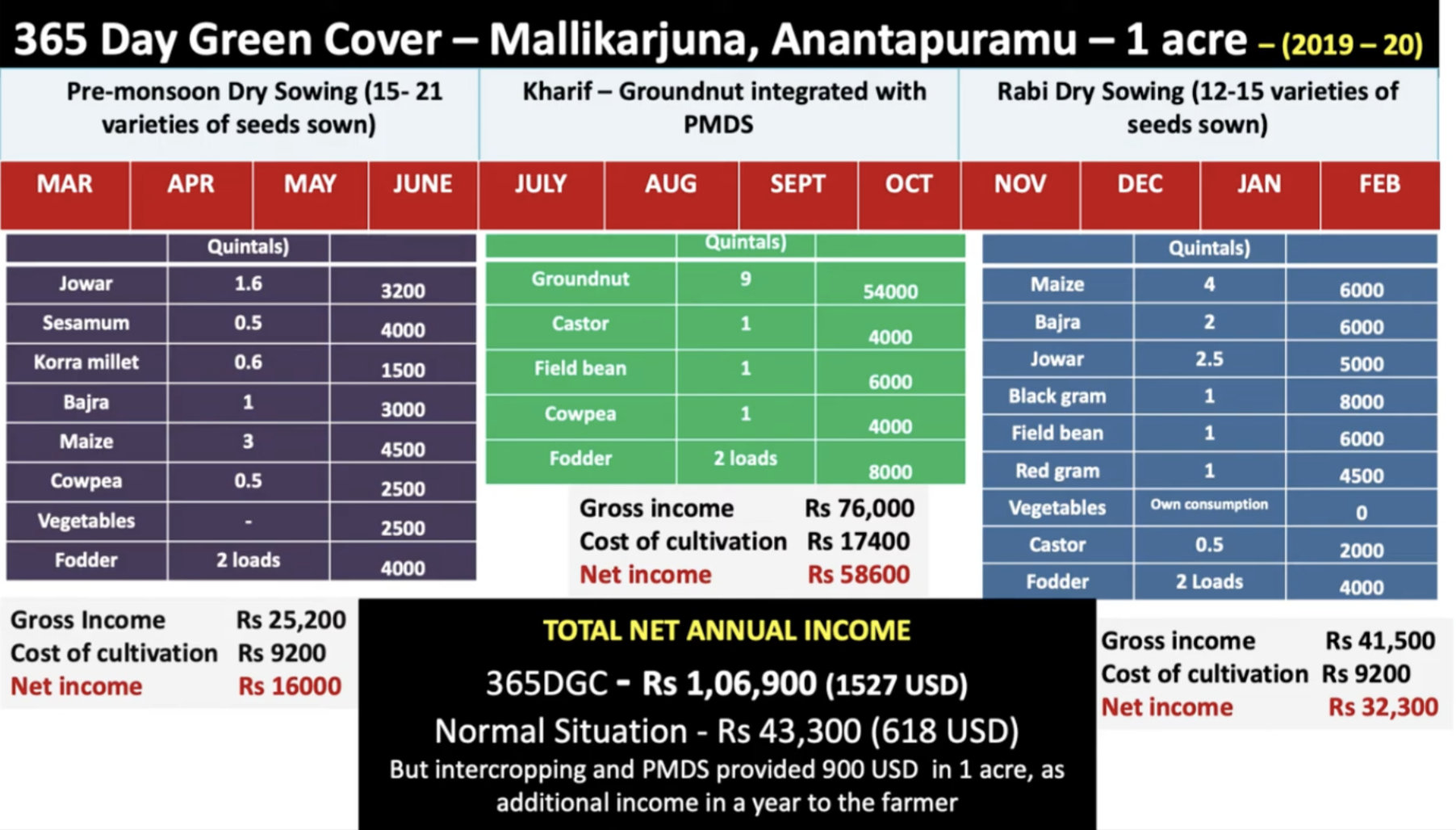
Source: Brown’s Ranch
Agroecology: the alternative to the Green Revolution
In Africa, Dr. Million Belay of the Alliance for Food Sovereignty in Africa (AFSA) calls his work Agroecology (an earlier term that sets forth 13 principles encompassing most of what is now called regen ag). While Western interests like the Gates Foundation seek to impose the industrialization of the Green Revolution on Africa, in a program called AGRA, Dr. Belay’s work with AFSA has achieved the goals set — but not met — by AGRA. AFSA has doubled food production and brought authentic food security to areas previously vulnerable to famine.
Transforming how we feed ourselves
This work is critical because famine is spreading. The World Food Programme reports that the number of hungry people has tripled since 2019, with 349 million people currently starving in 79 countries around the world. Even before the pandemic, the world faced food shortages. The COVID-19 pandemic dramatically worsened the problem. Conflicts in many areas of the globe force millions of people to become refugees. Climate change threatens global food supplies, even as the way we do most food production worsens climate change. Even in the U.S, nearly 32 million people — more than 10% of households — experienced some food insecurity before COVID and through 2021. With inflation and evictions on the rise, that number is expected to grow.
Dr. Martin Frick, Director of the Global Office of the World Food Programme, notes this unexpected rise in food insecurity could force the UN and the world’s economies to shift direction:
Hunger was once considered the world’s greatest solvable problem. As recently as 2015, the United Nations were confident with the Sustainable Development Goals that they would soon be able to end hunger. The numbers fell continuously. By 2030 it would be zero, according to the plan. The three Cs, conflicts, climate crisis and cost explosion have turned hunger into a conflagration and destroyed the calculation.
But there is a plan B. It recognizes that crises are more complex, interdependent. To fight hunger effectively means more than keeping people on life-saving humanitarian aid for years. Eighty percent of the starving are small farmers, many of them women. But they are the engine of a change that has to start at the bottom, with the soil. Good smallholder agriculture makes soil fertile again. This restores ecosystems, livelihoods and the dignity of former aid recipients. This is not a green utopia, but the successes can be seen in WFP’s work in the Sahel. Plan B must now become the master plan.

Dr. Martin Frick at a refugee camp on the Syrian/Lebanese border, World Food Programme. Credit: UN WFP
WFP’s move into regenerative agriculture is the only way it can succeed in its dual mandate to save the lives of people caught in crises, and to improve the lives and resilience of the world’s poorest.
Many urban and suburban dwellers tend to think that food comes from a grocery store, forgetting that such establishments date only from the late 1940s. Food comes from the hard work and spare lifestyles of rural residents. The brittle supply chains bringing produce from half a world away are not resilient. They broke under COVID. Prized products, from toilet paper to bacon, disappeared from store shelves. Food lines stretched for blocks. The system of vertically integrated, confined animal feeding operations delivered 105 billion pounds annually of poultry, pork, beef and lamb in the U.S, nearly double what it produced three decades ago. But this model of “cheap” food efficiency is unable to cope with dislocation. It also imposes misery on animals and unhealthy food on us. Industrially warehoused animals are fed corn and soy, or industrial wastes, which they were never designed to eat. This makes them unhealthy, so we load them up on antibiotics, endangering human health care systems.
There is a plan B. It recognizes that (regenerative) agriculture makes soil fertile again . . . restores livelihoods and the dignity of former aid recipients . . . Plan B must now become the master plan.
The harsh reality of industrial meat production
Most meat processing in the U.S. takes place in a few inhumane plants controlled by four corporations: Tyson Foods, Smithfield Foods, JBS USA Holdings Inc., and Cargill Inc. These process over 80 percent of the beef and more than 60 percent of poultry and pork sold in supermarkets. Poultry is so vertically integrated that corporations like Tyson even own the chickens. During COVID, meat processing capacity in the U.S. dropped 40 percent. That created 200,000 excess pigs a day, which became a million pigs a week with nowhere to go but mass graves: the meatpacking plants to process them were closed by COVID. Millions of chickens, pigs and cattle were killed because front-line workers in the meat packing plants, operations more reminiscent of Upton Sinclair’s The Jungle, than the corner butcher shop, began dying of COVID.
One report observed: “The same features that allow a steady churn of cheap meat also provide the perfect breeding ground for airborne diseases like the coronavirus: a cramped workplace, a culture of underreporting illnesses, and a cadre of rural, immigrant and undocumented workers who share transportation and close living quarters….As of May 20, 2020 officials have publicly linked at least 15,300 COVID-19 infections to 192 U.S. meatpacking plants, according to tracking by the Midwest Center for Investigative Reporting. At least 63 workers have died.” In the 1950’s meatpacking workers were unionized, and earned almost $35,000 a year, with paid sick time. Now the norm is under $30,000, and only one in five American packers are unionized.
Farm laborers and grocery store workers are also at risk. The United Food and Commercial Workers (UFCW) International Union, warns that more than 100,000 grocery workers were exposed to COVID and 68 died. A study by Oklahoma State University projected that the pandemic bled an estimated $13.6 billion from the beef industry. Prices to the consumer rose, but livestock prices for farmers collapsed.
As COVID numbers dropped, the industrial system swung back into high gear, but should it? Clearly, one of the challenges to the industry is to ensure worker safety, and rethink the supply chains to make them more locally robust and resilient.
In contrast to the industrial farming practices now imperiling human ability to grow food, regenerative agriculture accepts the science that small-holder organic farming is the best way to feed the world. It revitalizes rural communities as it improves the health of our food and the environment on which food production depends.
Revitalizing rural culture
Studies have shown that areas with high rates of organic farming have lower levels of poverty and higher household incomes. The St. Louis Federal Reserve Bank identified 225 counties in the U.S. as “organic hotspots” — counties with high levels of organic agricultural activity that have neighboring counties with high organic activity. It found that the organic hotspots impact key county-level economic indicators, boosting household incomes and reducing poverty levels. Organic hotspots increased prosperity at greater rates than general agriculture activity, and even more than major anti-poverty programs. Being an organic hotspot increases median household income by over $2,000, and lowers a county’s poverty rate by as much as 1.35 percentage points.
Regen ag is attracting major agricultural companies. General Mills has committed to help farmers on a million acres implement regenerative practices. Danone, Kellogg, Nestlé, and a dozen other companies, at the 2019 UN Climate Action Summit announced the One Planet Business for Biodiversity (OP2B) coalition to promote regen ag.
An M+R Strategic Services study found that organic agriculture creates 21% more jobs than conventional agriculture, with 28,000 jobs for every $1 billion in sales. A similar UK study found that organic agriculture delivers 32 percent more jobs than conventional.
Most federal farm programs only support big farming. Globally agricultural subsidies top $1 million a minute. A recent report from the Food and Land Use Coalition called for a 10-point program to reverse destructive agriculture practices, including:
2: Scaling productive and regenerative agriculture
3: Protecting and restoring nature
4: Securing a healthy and productive ocean
5: Diversifying protein supply
6: Reducing food loss and waste
7: Building local loops and linkages
8: Harnessing the digital revolution
9: Delivering stronger rural livelihoods
10: Improving gender equality and accelerating the demographic transition
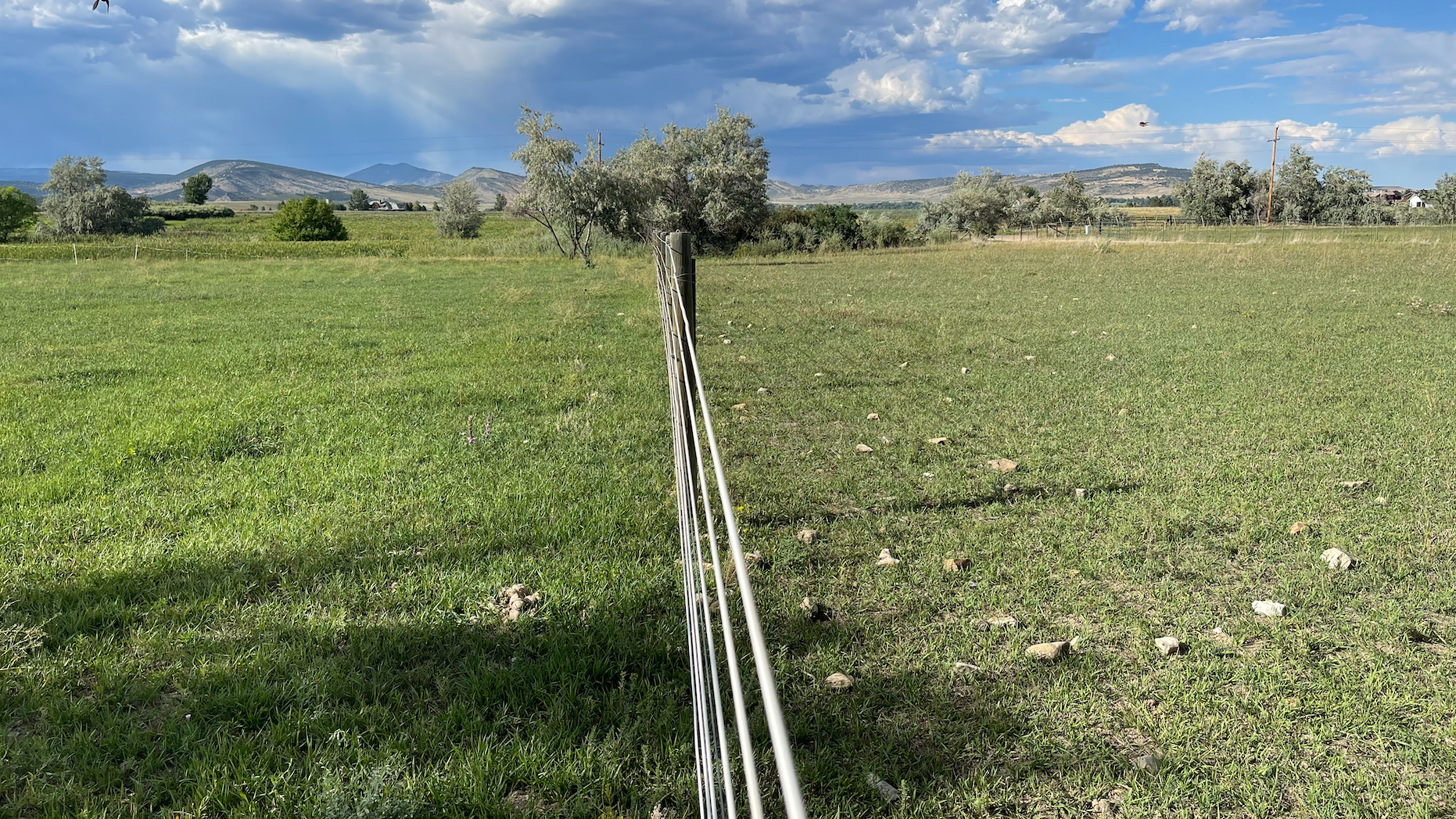
Holistic grazing on the left, conventional management on the right.
The European Union recently published its Farm to Fork and Biodiversity strategies. It called for 25% of European agriculture to be organic by 2030. as part of its strategy on the European Green Deal. This calls for:
- Reduction in pesticides by 50% and fertilizers by 20% by 2030 and an increase in organic farming.
- EU sales for antimicrobials for farmed animals and in aquaculture will be reduced by 50% while the share of organic farming would be increased by 25% by 2030.
- “The EU Commission is committed to halve per capita food waste at retail and consumer levels by 2030,” The Alliance Center reported. It will use new data expected by the member states in 2022 to set a baseline for legally binding targets.
It calls for sustainable food systems that:
- have a neutral or positive environmental impact
- help to mitigate climate change and adapt to its impacts
- reverse the loss of biodiversity
- ensure food security, nutrition and public health, making sure that everyone has access to sufficient, safe, nutritious, sustainable food
- preserve affordability of food while generating fairer economic returns, fostering competitiveness of the EU supply sector and promoting fair trade
Even in the U.S. change might be coming. U.S. Senators Elizabeth Warren and Cory Booker introduced The Farm System Reform Act. It would impose an immediate ban on new CAFOs and phase out all large factory farming by 2040, with voluntary buyouts for smaller operations. “The COVID-19 crisis will make it easier for Big Ag to get even bigger, gobble up smaller farms, and lead to fewer choices for consumers… We need to start reversing the hyper-concentration in our farm economy,” the Alliance Center reported.
The growing popularity of regen ag is, ironically, attracting major agricultural companies. General Mills has committed to help farmers on a million acres implement regenerative practices. Danone, Kellogg, Nestlé, and a dozen other companies, at the 2019 United Nations Climate Action Summit in New York City, announced the One Planet Business for Biodiversity (OP2B) coalition to promote regen ag, and the coalition now includes more than two dozen global companies. Land O’Lakes, the large dairy conglomerate, promised to increase sustainability on 1.5 million acres of U.S.-grown corn. Microsoft pledged to go not only carbon neutral, but carbon negative by 2030 using regenerative agriculture and nature-based solutions to remove all of the carbon that the company ever emitted. Walmart, for whom I consulted in the early days of their sustainability program, pledged in 2020 to become a regenerative company. The world’s biggest company by revenue ($573 billion in 2022) Walmart is still working out what that means. It is good that these giants are seeking to transform, but essential that we realize that authentic regen ag starts by listening to the farmers on the ground and supporting small-holder producers.
Find a farmers’ market near you, and go talk to and support the people who are transforming agriculture in your own community. I promise you, that tomato will taste better. And you’ll have become a part of solving the climate crisis.
Taking regenerative agriculture to scale certainly is better than continued reliance on industrial production of the food we eat. And the natural and organic foods sector is growing. Nationally, the food market as a whole grows at a bit over 1%, but the organic market, now at over $50 billion a year, grows at over 5% annually. When COVID shut big supply chains, more people looked to local agriculture. Subscriptions for Community Supported Agriculture are on a waiting list basis. Local dairies that deliver saw dramatically increased business. Joe Cloud, who owns T&E Meats in Harrisonburg, Virginia, observed: “These big plants are being forced to shut down, they slaughter 6,500 animals a day — six times my annual output. A plant like mine is inefficient and our meat prices are higher, but there’s a lot more resiliency.”
Interestingly, some small-scale farmers, although they were largely excluded from bailout programs, adapted better than industrial competitors. Where possible, they grow their own organic seed, rejecting costly industrially produced, genetically modified, chemically-coated seed. They trade locally for what they cannot produce themselves, creating a vibrant web of community. Nationally, more than 167,000 small farms sell $8.7 billion worth of meat and produce directly to consumers, restaurants and retailers each year. Although some farm stands and farmers markets closed in the pandemic, many shifted their businesses online, and farms across the country reported that customers followed in droves. Huffington Post profiled Longmont’s Sky Pilot Farms, scramble to meet increased demand from on-line and drive-up customers to their farm stand.
Your role in the solution
There is overwhelming support for regenerative agriculture as a climate solution. The recent Yale study showed that 84% of registered voters (including 91% of moderate Republicans and 92% of moderate Democrats) support “providing federal funding to help farmers improve practices to protect and restore the soil so it absorbs more carbon”. A Walton Family Foundation study showed that nearly 90% of Americans believe that it’s “important to update the agricultural system to encourage sustainable farming practices that support clean water and healthy, productive soil.”
You can decide what you want to eat and where you want to shop. But the next time you go to the grocery, consider that you have a choice. You can support Gabe and his North Dakota farm by ordering from Nourished By Nature, or from White Oak Pastures, Will Harris’s operation. Or get courageous: Find a farmers’ market near you, and go talk to and support the people who are transforming agriculture in your own community. I promise you, that tomato will taste better. And you’ll have become a part of solving the climate crisis.
Featured image: Hunter Lovins at her Nighthawk Horse Company ranch in Longmont, Colorado. Credit: Rob Noiles


